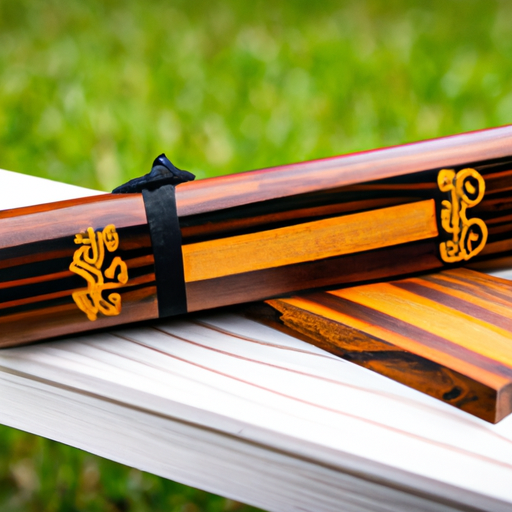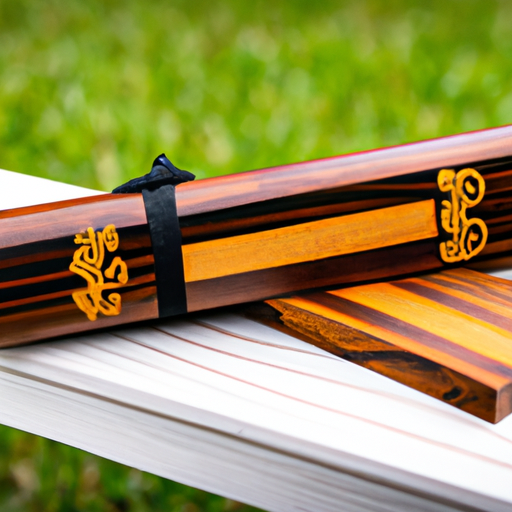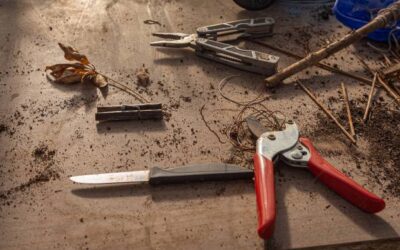In this article, you will learn about the importance of seasonal maintenance for your Japanese garden tools. Taking care of your tools is essential in order to keep them in good condition and ensure they last for a long time. By following some simple maintenance tips, you can keep your tools sharp and ready to use.
During each season, there are specific tasks you should do to properly maintain your Japanese garden tools. In the spring, it is important to clean and oil your tools to remove any dirt or rust that may have accumulated over the winter. In the summer, pay attention to the humidity and moisture level in your storage area, as excessive heat and moisture can damage your tools. In the fall, make sure to check for any signs of wear and tear, and if necessary, repair or replace any damaged tools. And in the winter, it is important to properly store your tools and protect them from the elements. By following these seasonal maintenance tips, you can keep your Japanese garden tools in top shape all year round.

The Importance of Seasonal Maintenance
Maintaining your Japanese garden tools is essential to ensure their longevity and optimal performance. By regularly performing seasonal maintenance, you can prevent damage, rust, and deterioration, and guarantee a safe and efficient gardening experience. This article will guide you through the importance of seasonal maintenance for Japanese garden tools, the steps involved in each season, common mistakes to avoid, the benefits of regular maintenance, and when to consider professional help. Follow these guidelines to keep your tools in pristine condition and enjoy the rewarding results of proper maintenance.
Why is Seasonal Maintenance Important for Japanese Garden Tools?
Japanese garden tools are not just ordinary gardening tools; they embody the rich history, tradition, and artistry of Japanese gardens. They are crafted with precision and care, using high-quality materials and traditional techniques. To preserve their beauty and functionality, seasonal maintenance is crucial. Neglecting seasonal maintenance can result in various negative effects, including rust, dullness, wooden handle deterioration, and even broken or damaged tools. By devoting time to regular maintenance, you can prevent these issues and extend the lifespan of your Japanese garden tools.
The Effects of Neglecting Seasonal Maintenance on Japanese Garden Tools
When you neglect seasonal maintenance for your Japanese garden tools, you expose them to various risks that can compromise their performance and lifespan. Without proper cleaning and storage, tools can accumulate dirt, rust, and debris, leading to corrosion and deterioration. Dull blades can make your pruning and trimming tasks more challenging and less precise. Damaged wooden handles can become weak and ineffective, compromising your grip and control. By neglecting seasonal maintenance, you risk using tools that are unsafe, inefficient, and prone to further damage. Therefore, it is vital to prioritize regular maintenance to prevent these negative effects.
Spring Maintenance
Spring is a crucial time to perform maintenance on your Japanese garden tools after the harsh winter months. Here are the essential steps to keep in mind:
Cleaning and Polishing Tools
Start by thoroughly cleaning your tools to remove any dirt, debris, or rust that may have accumulated during winter. Use warm water, mild soap, and a scrub brush or sponge to scrub away dirt and grime. Pay extra attention to the blades, ensuring they are free from any residue. Once cleaned, dry the tools thoroughly to prevent rust formation.
After cleaning, consider polishing your tools to enhance their appearance and provide additional protection against rust. Apply a thin layer of a non-toxic polish or oil, such as camellia oil or mineral oil, to the metal parts of your tools. Wipe off any excess oil and let the tools dry before storing.
Sharpening Tools
Sharpening your tools is essential to ensure their cutting ability and precision. Use a sharpening stone or file specifically designed for the type of tool you are sharpening. Follow the manufacturer’s instructions and take your time to achieve the desired sharpness. Remember to sharpen both sides of the blade evenly and maintain the original angle. Test the sharpness by making a few cuts on a piece of paper or a small branch. If needed, continue sharpening until the tool cuts smoothly.
Inspecting and Repairing Damaged Tools
Inspect your tools carefully for any signs of damage, such as cracks, chips, or loose parts. Replace or repair any damaged tools to prevent further deterioration and ensure safe use. You may need to consult a professional or reach out to the tool manufacturer for specialized repairs or replacement parts. By addressing damage promptly, you can avoid accidents and maintain the quality of your Japanese garden tools.
Summer Maintenance
Summer maintenance focuses on cleaning and protecting your Japanese garden tools from the effects of heat, humidity, and potential rust formation. Here are the essential steps to follow:
Cleaning and Oiling Tools
Continuing proper cleaning practices during the summer months is essential to remove any dirt, plant sap, or residue that may have accumulated during gardening activities. Use the same cleaning techniques mentioned in the spring maintenance section.
After cleaning, apply a thin layer of oil to the metal parts of your tools to provide an additional protective barrier against rust. Camellia oil or mineral oil are excellent choices for this purpose. Wipe off any excess oil and allow the tools to fully dry before storing them.
Storing Tools Properly to Prevent Rust
Proper storage is key to prevent rust formation on your Japanese garden tools during the hot and humid summer months. After cleaning and oiling, store your tools in a dry and well-ventilated area. Avoid storing them directly on the ground or in areas prone to excessive heat or moisture. Consider using a dedicated tool storage rack or a toolbox with compartments to keep your tools organized and protected. Regularly inspect the storage area and tools for any signs of rust or damage, addressing any issues promptly.
Fall Maintenance
Fall maintenance is essential to prepare your Japanese garden tools for storage during the winter months. Follow these steps to ensure their longevity:
Cleaning and Preparing Tools for Storage
Before storing your tools for the winter, thoroughly clean them using the same techniques mentioned in the previous sections. Remove any dirt, debris, or plant material to prevent corrosion and deterioration during storage. Dry the tools completely to avoid moisture-related damage.
Once cleaned, organize and arrange your tools in a suitable storage container or toolbox. Avoid overcrowding to prevent damage or accidental scratching. Consider using dividers or foam inserts to keep each tool separate and protected. Label the container, so you can easily identify and retrieve your tools when needed.
Applying Protective Coatings to Wooden Handles
Wooden handles require special attention to prevent drying and cracking. Apply a protective coating or sealant specifically designed for wooden surfaces to keep them in optimal condition. Be sure to follow the manufacturer’s instructions and allow sufficient drying time before storage. Regularly inspect the wooden handles for any signs of damage or wear, applying touch-ups as necessary.

Winter Maintenance
During the winter, it is crucial to store your Japanese garden tools properly to prevent freezing, rust, and further deterioration. Consider the following steps:
Proper Storage of Tools to Prevent Freezing
Before storing your tools for the winter, ensure they are completely clean and dry. Moisture left on tools can freeze and cause damage. Store your tools in a cool, dry, and frost-free environment. Avoid exposing them to extreme temperature fluctuations or storing them near heating sources. Proper storage in the winter months will help preserve the integrity of your Japanese garden tools until the arrival of spring.
Checking and Replacing Worn-out Parts
Inspect your tools in the winter months and check for any signs of wear, including loose parts, damaged blades, or deteriorated wooden handles. Replace any worn-out parts promptly to maintain the performance and safety of your tools. Consult a professional or reach out to the relevant manufacturer if you require specialized replacement parts or repairs.
Choosing the Right Tools for Japanese Gardens
To ensure efficient and productive gardening in a Japanese garden, selecting the right tools is crucial. Consider the following factors:
Understanding the Various Types of Japanese Garden Tools
Japanese garden tools come in various forms and each has its specific purpose. From pruning shears (niwaki-basami) to hand rakes (kumade) and bamboo brooms (hochibi), understanding the different tools and their functions is essential for effective gardening. Research the specific tools required for the tasks you plan to undertake in your Japanese garden and invest in high-quality options.
Considerations for Selecting High-Quality Tools
When choosing Japanese garden tools, prioritize quality over price. Look for tools crafted from high-quality materials, such as forged steel or high-carbon steel, that are known for their durability. Check for solid construction and ergonomic designs that ensure comfort and ease of use. Additionally, read customer reviews and seek recommendations from experienced gardeners or experts to make informed purchasing decisions.
Common Mistakes to Avoid in Japanese Garden Tool Maintenance
To ensure the longevity of your Japanese garden tools, avoid the following common mistakes:
Overlooking Maintenance Due to Busy Schedules
It is easy to neglect maintenance when you have a busy schedule. However, remember that regular maintenance can prevent costly repairs or replacements in the future. Dedicate specific times for seasonal maintenance and make it a priority in your gardening routine.
Using Improper Cleaning Techniques
Using improper cleaning techniques can damage your Japanese garden tools. Avoid using harsh chemical cleaners, wire brushes, or abrasive materials that can scratch or dull the surfaces. Stick to mild soap, warm water, and non-toxic polishing or oiling products. Read the tool manufacturer’s recommendations for cleaning and maintenance, and follow them accordingly.
Benefits of Regular Maintenance
Regular maintenance of your Japanese garden tools offers numerous benefits, including:
Extending the Lifespan of Japanese Garden Tools
By performing routine maintenance, you can prevent rust, corrosion, dullness, and other issues that can shorten the lifespan of your tools. With proper care, your Japanese garden tools can last for many years, allowing you to enjoy the beauty and functionality they provide.
Ensuring Safe and Efficient Gardening Practices
Well-maintained tools are safer to use and allow for more efficient gardening practices. Sharp blades and sturdy handles enable precise cuts and better control over your gardening tasks. Additionally, regular maintenance ensures the tools function as intended, reducing the risk of accidents and injuries.
Professional Maintenance Services for Japanese Garden Tools
While regular maintenance can be done by yourself, there are instances when seeking professional help is necessary. Consider the following scenarios:
When to Seek Professional Help in Maintaining Japanese Garden Tools
If you encounter complex repairs or require specialized knowledge for maintaining your Japanese garden tools, it may be best to enlist the help of professionals. They have the expertise and experience to handle intricate repairs, source rare replacement parts, and provide recommendations for optimal tool performance.
Choosing a Reliable and Experienced Maintenance Service
When selecting a professional maintenance service, prioritize reliability and experience. Look for businesses or individuals with proven track records in Japanese garden tool maintenance. Read customer reviews, ask for recommendations, and inquire about warranties or guarantees provided. Doing thorough research ensures you choose a reliable service that will take excellent care of your valuable tools.
Conclusion
Proper seasonal maintenance is vital to maintaining the longevity and effectiveness of your Japanese garden tools. By following the outlined steps in each season, you can prevent damage, rust, and deterioration. Remember to choose high-quality tools suited for Japanese gardening, perform regular maintenance, and avoid common mistakes. The rewards of proper seasonal maintenance are plentiful, including extended tool lifespan, safe gardening practices, and enhanced beauty and functionality. And while DIY maintenance is possible, seeking professional help when needed ensures your valuable Japanese garden tools receive optimal care.








